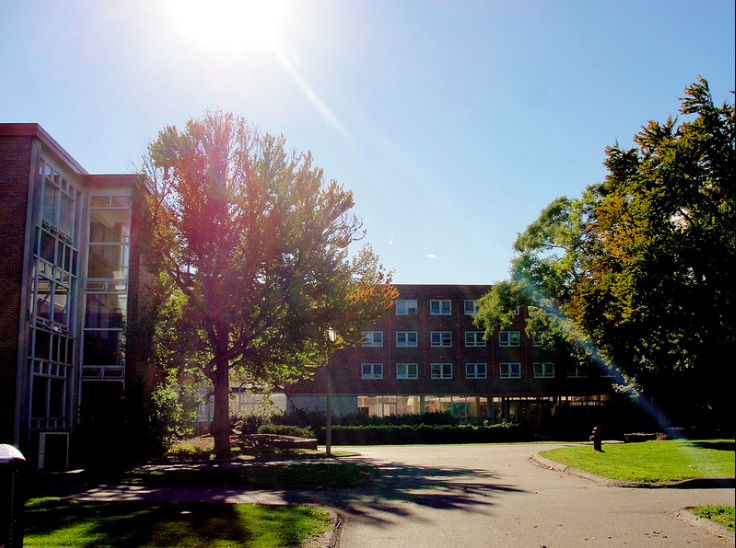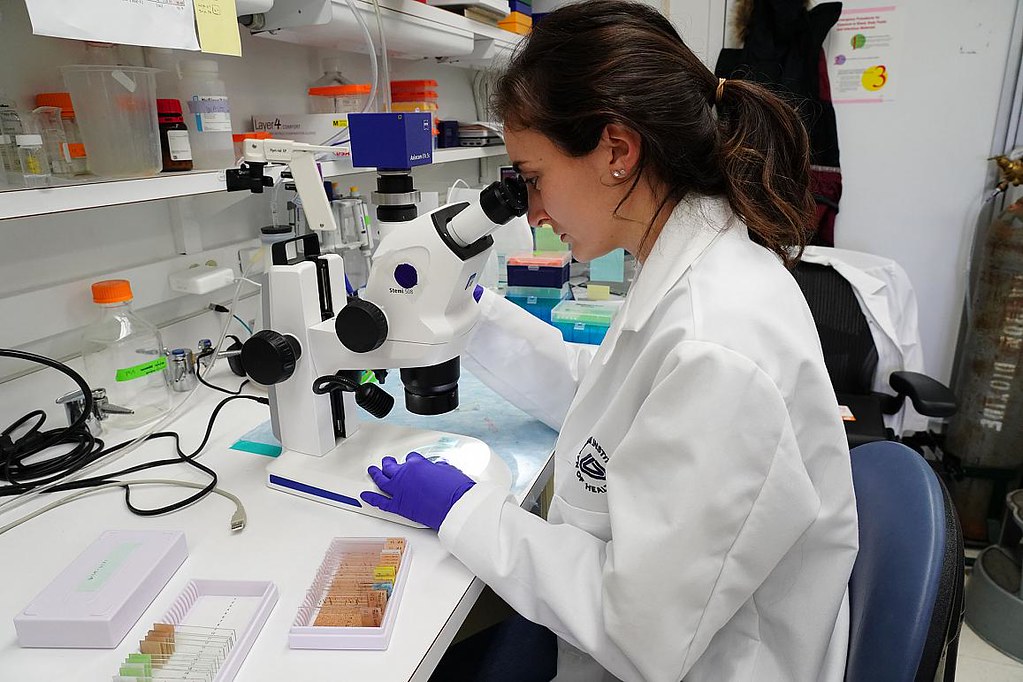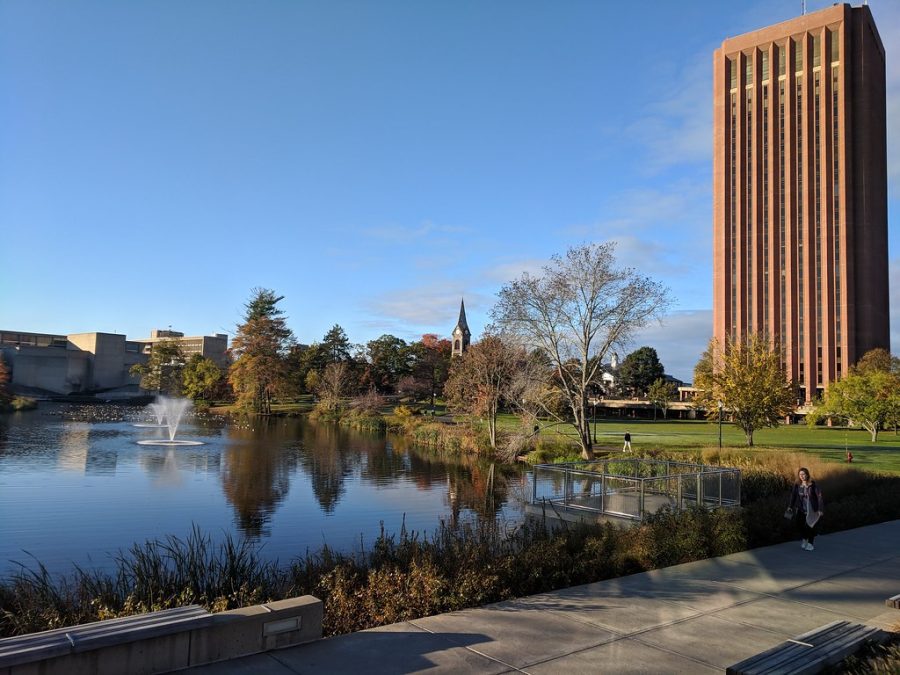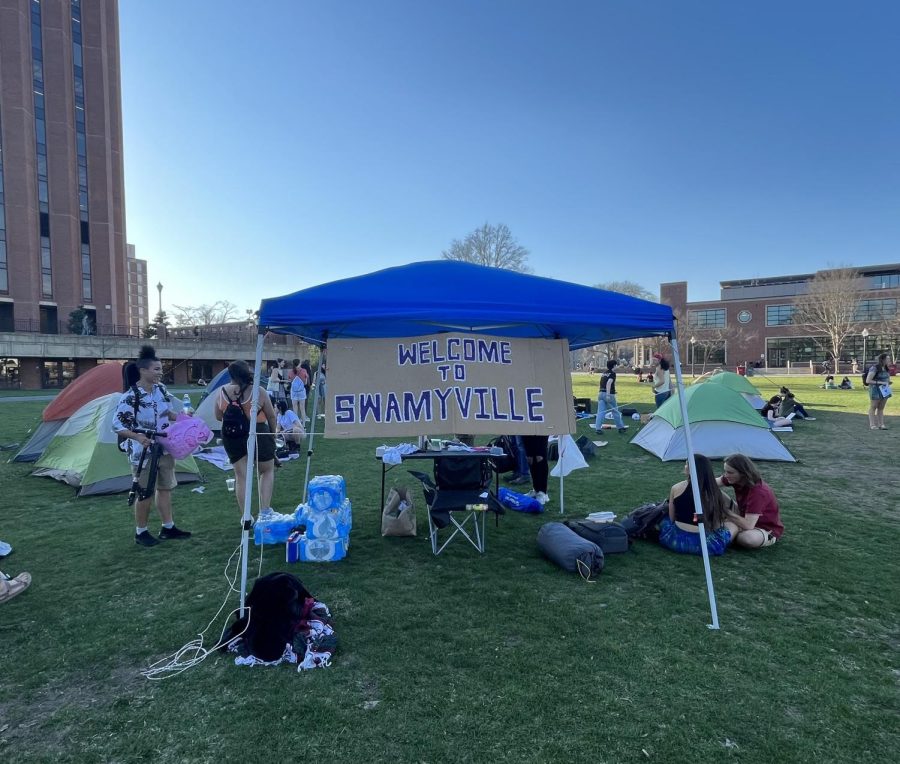by Veronica Stracqualursi
AMHERST, Mass. – Constructed in 1960, Bartlett Hall is nearing the end of its days. Asbestos grows on the crumbling walls and ceiling. Its classrooms and offices are unbearably hot during the summer and cold in the winter, mostly due to the heat not working. There have even been rumored sightings of rodents, bats and probably cockroaches.
Many on campus see Bartlett as a dilapidated and outdated building that needs to go, but for Bartlett’s students and faculty, it’s much more than that – it’s a second home.
“I’m a little torn because it’s been my academic home for the past two and half years, and so I have a love for it that way,” English major Zachary Grobe said. “Some of my best memories at UMass were in Bartlett [but] the building itself is a disappointment to me.”
Changes are in the works.
By the year 2016, UMass hopes to move every department out of Bartlett, knock down the old building and begin constructing a new facility in its place. An addition to South College called the South College Academic Facility (SCAF) will be built, providing the College of Humanities and Fine Arts with a much needed, new centralized space.
Bartlett currently houses five departments: Women, Gender and Sexuality Studies (WGSS), English, Art History, Philosophy and Journalism. This fall, Journalism will be upgraded to the New Academic Classroom Building.
The remaining majors, all part of the College of Humanities and Fine Arts, would assumedly move to SCAF. Unfortunately, not every department has a secure spot in the new SCAF as was originally promised.
One of the main concerns within the College of Humanities and Fine Arts is that the learning community faculty is in danger of being dismantled. Keeping intact the network of staff and professors along with the learning atmosphere throughout the various Humanities departments is an important part of the moving process.
“The process concern [of building] only matters in relationship to the more important concern,” English Professor Laura Doyle said. “Which is the preservation of the excellent teaching and learning that we’ve been able to do in Bartlett despite its decrepit conditions.”
WGSS and Art History have an uncertain answer as to whether they will be included in the new academic building.
“I came here [to UMass] with the understanding that there was a point in the not too distant future that WGSS will have better space,” said WGSS Chair Laura Briggs, who started working at UMass two years ago. Briggs was frustrated when she first received an email notifying her that along with Art History, WGSS was on the lower half of the list of departments prioritized for SCAF.
In an email sent to the Chancellor, Associate Provost, and the project manager, Briggs argued, “Of course, WGSS came out lower on the list. It always has.”
According to the Director of Campus Planning, Dennis Swinford, Campus Planning considered the size of each department to determine which majors would go into SCAF. WGGS and Art History are smaller. Swinford also said the Dean’s Office and Advising for the College of Humanities and Fine Arts were prioritized before because they believed the two would greatly improve a student’s experience.
But, Swinford assures that the administration is still figuring out how to include WGSS and Art History in the new building. The other option for the two departments is Machmer Hall, and Art History has one more alternative placement in the Fine Arts Center.
Right now, the WGSS major is on every floor and corner of Bartlett. Moving to Machmer would allow the major to be consolidated, but be separate from the other Humanities and Fine Art departments – something none of the departments want as an outcome.
Another point of contention is the issue of money. The budget for SCAF is $50 million and has been for three years now, but Swinford said the cost of building has increased significantly because the construction industry has since gone through an economic boom.
“Things have gotten more expensive quicker than we had anticipated,” Swinford explained. “Three years ago, we were in a different economy.”
Some feel that $50 million is not enough.
“We can be one of the universities that actually preserves our strength in the humanities and arts and showcase it instead of making this building the minimum it can be,” Professor Doyle said. “It would be the loss of strength if we don’t invest in this building.”
The money, though, comes from future student fees and tuition. Administration and faculty agree that no one wants to raise the budget because that would mean higher tuition and fees. But the College of Humanities and Fine Arts has not had an update to their facilities in over 30 years.
A town hall style meeting was held in Bartlett Hall 319 on December 3rd of last year for the Humanities students, faculty and professors. The room was packed that evening, with every seat taken, and plenty of people left standing as attendees voiced their questions and concerns.
During the meeting, Bryan Harvey, the associate provost for UMass Amherst’s Academic and Resource Planning, called it a new culture of planning.
“I do give the administration a lot of credit for opening up the forum and allowing the undergrads, the grads and the faculty to feel as though they’re being involved in the process and these ongoing discussions,” said Grobe in a December 2013 interview.
But, Professor Doyle says communication between the administration and the College of Humanities and Fine Arts has not recently had the same momentum.
“We had some good meetings and yet we feel that has begun to falter since December,” Doyle said. “We tried to get a meeting in January to get a look at some of the preliminary plans and that has not been pursued or enabled by the administration.”
Swinford said that there are town hall meetings planned in the near future, but that Campus Planning certainly could make it happen. As of late, Campus Planning is taking a newer approach to the issue of SCAF.
“Each of the departments and each of the issues have their own set of variables that we’re going to solve independently,” Swinford said.
Doyle is also part of the Coalition Committee for Humanities Facilities, which was formed in response to the planning of South College Academic Facility (SCAF).
Another English Professor and member of the Coalition, David Fleming, posted on his blog in December 2013, “A Coalition Committee for Humanities Facilities has been formed and is pushing for transparency and inclusiveness in the planning of SCAF.” There are about eight members in the Coalition, with at least one representative from each Humanities department.
The Coalition isn’t demanding extravagant renovations and fancy classrooms in SCAF. Professor Doyle said the College of Humanities and Fine Arts simply wants small classrooms meant for classes of 20 students or 30 to 45 students, which is vital to their teaching and for facilitating discussions.
“That’s where ideas are exchanged in the easiest way and so you can’t really have a successful English class in a large lecture hall,” English Society President Grobe argued.
The Coalition also wants to get rid of the desk chairs and instead have appropriate furniture for the classrooms.
According to Swinford, the new building will have a mixture of small classrooms and one big lecture hall. But the inclusion of a big lecture hall doesn’t thrill the people of Humanities Departments.
“I want to solve classroom needs across the university,” WGSS’s Briggs said. “On the other hand, we want classrooms appropriate to the kinds of classes we teach.”
Ultimately, Campus Planning presents the plans to Chancellor Kumble Subbaswamy, who gets the final say. This division of Facilities and Campus Services has until March.
“We’d like to take him a solution instead of a problem, which we are working on,” Swinford said.
Veronica Stracqualursi can be reached at [email protected]







